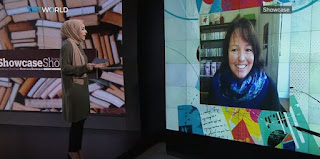My pirate book Kintana and the Captain's Curse is about a young girl who helps her ex-pirate pa run a pet shop on Pirate Island, Nosy Boraha, a small island off the north east coast of Madagascar.
Kintana craves a life at sea - so when she has the chance to join the crew of the Nine Sails a pirate ship - she is thrilled.
There is only one problem - the quartermaster thinks she is a boy, so Kintana must keep up the pretence or risk the wrath of the captain!
Women were often considered bad luck on ship, but there were real female pirates - the best known being Grace O'Malley (Gráinne Ní Mháille), Anne Bonny and Mary Read.
Grace O'Malley (1530 - 1603) is known as the Pirate Queen of Ireland. She was born at Belcare Castle, Westport and grew up on Clare Island, County Mayo. Her father was an Irish Chieftain and Grace's family earned their money from fishing, trading and taxing other fishermen.
At age 11 she decided to go to sea.
According to legend, her father refused to let her go, warning her long hair would catch in the ship's ropes. In response she cut off her hair, earning her the nickname Gráinne Mhaol - Bald Grace.
Another story about Grace is that an hour after having her baby while at sea, her ship was attacked by pirates. Grace wrapped her newborn son in a blanket, and went on deck to rally her crew, leading to the capture of the pirate vessel.
Grace travelled as far as Spain and the Isle of Barra in the Outer Hebrides, Scotland on her piracy missions, often stealing cattle on her trips. Between attacks she retreated to her home on Clare Island - a three storey 'tower house' that still exists - Granuaile's Castle.
At age 56, Grace was captured and imprisoned by Lord Bingham, the English Governor who was appointed to rule over Irish territories. She lost much of her power and money as a result.
In 1593, Grace had an audience with Queen Elizabeth I, to petition for the release of her son who had been arrested by Bingham. The Queen granted her requests on condition that she end all rebellion against the crown. But she refused to return land to Grace that Bingham had stolen from her.
Grace is thought to have died in her early 70s around 1601-1603. She is buried in the abbey on Clare Island.
Most of what is known about Anne Bonny and Mary Read comes from the book A General History of the Robberies and Murders of the most notorious Pyrates by Captain Charles Johnson, first published in 1724.
Anne Bonny was born near Cork in Ireland. Her father was an attorney at law, her mother was his family's maid! When news of the scandal broke, her father left his wife and went to Carolina in America with Mary and her mother where he became a successful merchant.
Anne was said to have a violent temper and Captain Johnson says she killed an English servant maid with a knife. Anne ran off with a young man 'who belonged to the sea and was not worth a groat.'
They took a ship to the Island of Providence. There Anne met the pirate John 'Calico Jack' Rackam nicknamed for the cotton clothing he wore.
Anne had lost interest in her husband, and was very taken with the pirate so when he suggested they elope together and go to sea with him, in men's clothing, she agreed.
Together they attacked coastal traders and fishing boats until one day they attacked a sloop.
On board Anne met a Dutch sailor and she was very taken with him.
Calico Jack became very jealous and was set to kill them both when it was revealed that the sailor was in fact an Englishwoman in disguise. Her name was Mary Read.
Mary Read was born in England. The book tells the story of how her mother disguised Mary as a boy after the death of her brother to deceive her mother-in-law into providing a crown a week in maintenance.
At age 13, Mary was put to work as a footboy, then later gained a place on board a man-of-war, In Flanders she became a cadet with a foot regiment, before switching to a cavalry regiment.
Mary fell in love with a Fleming comrade and they were later married, but their happiness was shortlived as her husband died a short time later.
Dressing in male clothing, she joined a vessel bound for the West Indies - the ship was taken by English pirates who kept Mary with them.
Susan Brownrigg is the author of Kintana and the Captain's Curse, and the Gracie Fairshaw series. (Uclan Publishing)
Find out more at susanbrownrigg.com





























